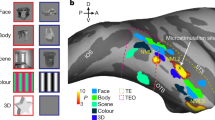Abstract.
Neurons in the anterior regions of the banks of the superior temporal sulcus (STSa) of the macaque monkey respond to the sight of biologically significant stimuli such as faces, bodies and their motion. In this study the responses of STSa neurons were recorded during the gradual occlusion of the experimenter and other mobile objects behind screens at distances of 0.5–4 m from the monkeys. The experimenter or other object remained out of sight for 3–15 s before emerging back in to view. We describe a population of neurons (n=33) showing increased activity during the occlusion of objects that was maintained for up to 11 s following complete occlusion (when only the occluder itself was visible). This increase in activity was selective for the position of the occlusion within the testing room. Many neurons showed little or no change in activity prior to occlusion when the object or experimenter was completely in view. By coding for the presence and location of recently occluded objects, these responses may contribute to the perceptual capacity for object permanence.
Similar content being viewed by others
Author information
Authors and Affiliations
Additional information
Electronic Publication
Rights and permissions
About this article
Cite this article
Baker, .C., Keysers, .C., Jellema, .T. et al. Neuronal representation of disappearing and hidden objects in temporal cortex of the macaque. Exp Brain Res 140, 375–381 (2001). https://doi.org/10.1007/s002210100828
Received:
Accepted:
Issue Date:
DOI: https://doi.org/10.1007/s002210100828




